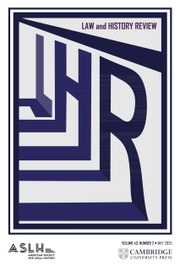No CrossRef data available.
Article contents
Ada Maria Kuskowski, Vernacular Law: Writing and the Reinvention of Customary Law in Medieval France Cambridge: Cambridge University Press, 2022. Pp. xviii, 412. $125 hardcover (ISBN 978-1-009-21789-7).
Review products
Ada Maria Kuskowski, Vernacular Law: Writing and the Reinvention of Customary Law in Medieval France Cambridge: Cambridge University Press, 2022. Pp. xviii, 412. $125 hardcover (ISBN 978-1-009-21789-7).
Published online by Cambridge University Press: 24 January 2025
Abstract
An abstract is not available for this content so a preview has been provided. Please use the Get access link above for information on how to access this content.
Information
- Type
- Book Review
- Information
- Copyright
- © The Author(s), 2025. Published by Cambridge University Press on behalf of American Society for Legal History

